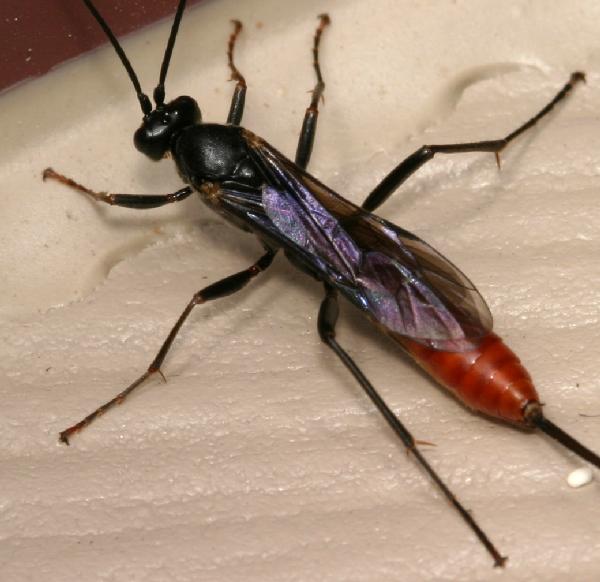Black Ichneumon with Red Abdomen
We found this black-and-red ichneumon wasp hanging around our porch light on August 1, 2010. Here it is in long form so that you can see the whole thing:
She’s probably Cryptus albitarsis, the most common of the ichneumon wasps that have this particular coloration. And we can be sure this is a “she”, because the males don’t have those long ovipositors.
BugGuide says that they lay their eggs in caterpillars of the Corn Earworm (Helicoverpa zea), the Oriental Fruit Moth (Grapholita molesta), and a few other agricultural pest caterpillars. I know the Corn Earworm tends to burrow inside the husks of ears of corn, and it sounds like the Oriental Fruit Moth digs inside of fruit, so this ichneumon wasp probably specializes in caterpillars that are normally hiding inside of plants. That long ovipositor would let her drill into ears of corn, or infested fruit, or other non-woody plants so she could lay her eggs on the caterpillars that have burrowed inside[1].
So, if you see these wasps around, leave them alone. The ear of corn you save may be your own.[2]
Incidentally, this brings up one of the problems with chemical control of agricultural pests. Let’s say that you are having corn earworms in your garden at a low level. You’re sick of it, so you go ahead and spray for the earworms. But, since the earworms are inside the developing ear of corn, they are largely protected from your spray, and very few of them get killed. Meanwhile, the parasitoid wasps that attack them and normally keep their numbers low, are very exposed. Your spray therefore kills almost all of the wasps. The net result is, your spray removes the predator, and now you get a population explosion of the earworms that you wanted to get rid of in the first place. Even if you plan ahead and are very, very careful about the timing, spraying only during the brief period when the adult moths are flying and are therefore exposed to the spray, this can be a problem. See, the parasitoids emerge from the hosts that they killed just shortly after the moths do. So you are still almost certain to kill a large fraction of the parasitoid wasps at the same time as you are killing the actual pests that you want to get rid of.
So how do you get around this? Well, there are a few choices: (1) Find a pesticide that is extremely specific, so it will kill the caterpillars but not the wasps; or (2) Encourage the wasps, so that they will keep the caterpillars controlled at a low level in the first place.
————-
[1] One could think of ichneumon wasps like this as being sort of like inverse woodpeckers: woodpeckers get rid of grubs and caterpillars by drilling holes into plants so they can pull them out, while the ichneumons get rid of them by drilling holes so they can get their eggs in.
[2] It looks like they also parasitize woolly caterpillars like those of the Isabella Moth, so that ovipositor would also be useful for getting past the defensive hairs that these caterpillars have all over their bodies.
Comments are closed.




This thing is boss
Cool! We saw one of these today at Bete Gris preserve and were curious what it was. A google image search for “insect with long orange body” led me to your photo and thus this blog post. So informative, and my kids love hearing about the parasitic wasp we saw. Then I noticed you’re in Atlantic Mine…cool blog!
So glad I found your site and this great info. One of these flew into my house and before I knew what it was, I managed to get it back outside without killing it. So glad I did after reading the above info and how beneficial they are. That stinger really looks intimidating but I’m [trying] to take a breath before panicking and learning more about these harmless insects.
Next, working on my snake phobia! LOL